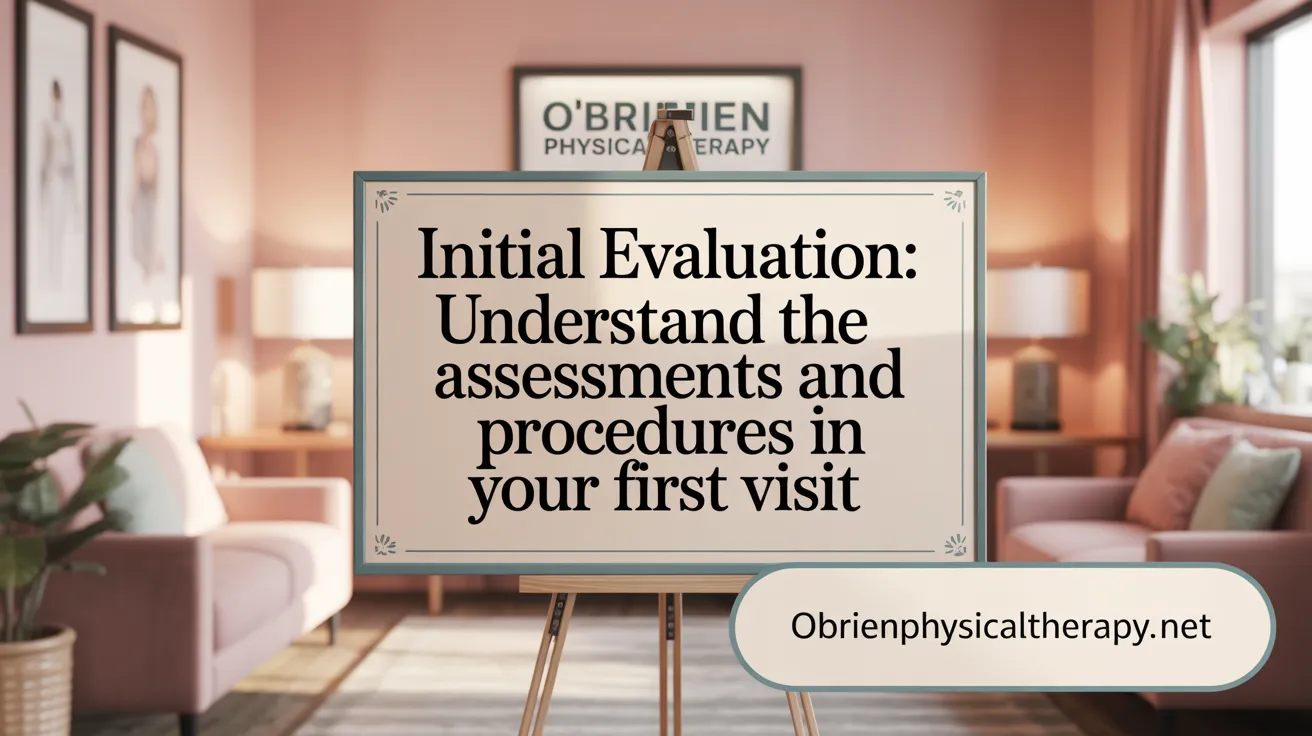Understanding the First Step in Your Recovery Journey
Beginning physical therapy can be a pivotal moment in your path to recovery, often filled with questions and uncertainties. This guide is designed to prepare you for your initial physical therapy session by outlining what to expect, how to prepare, and how the therapist will assess and tailor a treatment plan to your unique needs. Equipped with this knowledge, you can approach your first appointment with confidence and clarity.
<!-- VIDEO:eyJsaW5rIjoiaHR0cHM6Ly93d3cueW91dHViZS5jb20vd2F0Y2g/dj1aeGdERVI4TjJqMCIsImltYWdlVXJsIjoiZGF0YTppbWFnZS9qcGVnO2Jhc2U2NCwvOWovNEFBUVNrWkpSZ0FCQVFBQUFRQUJBQUQvMndDRUFBa0dCd2dIQmdrSUJ3Z0tDZ2tMRFJZUERRd01EUnNVRlJBV0lCMGlJaUFkSHg4a0tEUXNKQ1l4Sng4ZkxUMHRNVFUzT2pvNkl5cy9SRDg0UXpRNU9qY0JDZ29LRFF3TkdnOFBHamNsSHlVM056YzNOemMzTnpjM056YzNOemMzTnpjM056YzNOemMzTnpjM056YzNOemMzTnpjM056YzNOemMzTnpjM056YzNOLy9BQUJFSUFGTUFsQU1CRVFBQ0VRRURFUUgveEFBYkFBQUJCUUVCQUFBQUFBQUFBQUFBQUFBREFRSUVCUVlBQi8vRUFEY1FBQUlCQXdNQkJnUUZBd01GQUFBQUFBRUNBd0FFRVFVU0lURUdFeUpCVVdFVU1uR0JORUpTa2JFV0k2RVZ3ZEVrTTJKeWd2L0VBQm9CQUFJREFRRUFBQUFBQUFBQUFBQUFBQUVDQUFNRUJnWC94QUF0RVFBQ0FnRUNCUUlGQlFFQkFBQUFBQUFBQVFJUkF5RXhCQklUUVZFVU1tR1JvYkh3Y1lIUjRmSEJJdi9hQUF3REFRQUNFUU1SQUQ4QXg5ZFNjOGRVSWNhaEM3SFoyVnJpQ0FUa1BLc1RibmhaVnhJOFNqQi9OZ3lqUDBOWnZVS202L05mNEwrZzdTdjgvR01sMEpvbzU1SHVlSVZWbVFRdDNpQWduTHAxUURIbjZqMW9yaUxhU1cvNXA1QzhGSnV5RnFOcEhaekpISGNkL3VqU1FudXltQXloaDUrakNyTWMzTlcxUlZPQ2k5SFlCYVlBV05jMHJHTkgyV3Qxa3VHeU9nckR4ZXhzNGJjMUlzbDlLd1ViVHZnbDlLZ2JFTm1nSEl4UUlaN1ZkY3NyR2FhSUVPOGVBTnZPVDVpa2JIb2lMMnFzTzlBYUo5cDhzRGloekJvMDFySEJkd0xQQ1F5TU9EUkZDZkJMK21vUWFiSmZTZ0VqM21uaVcybGpYQUxvVkJQbG1vUTg1YnNacUFZajRoT1BUTk5RTEcxMGh6NFNPQ2FSa1dPR1J5K2RnVkNTMk91UFdnNUpic0tUZXdyVzF3c2U5N2VaWTkyemNZeUJ1Nll6NjBPYVBrbksvQktXYlU3YStNb1dlTzZ4R0RtRHhZVmtLY0VlcUpqMXg3bktjdU54cnRyL0FIOXgrYWFkOXpyZVhVNTRBbHZESk5Hc1hkQmt0UXpCTUZkdS9idUF4bGV2VGpvS2pqamk3YitvVkxJMXA5aU5LYmllVGRLcnM2eG9QbDVDS29DL2JhRjVwbHl4V2dqdGhIdGJpQWdUMjgwWlBsSkdWUHQxSHNmMk5UbWk5bUZ4YTNRZjRXNWlRU1MyODZJZUE3UnNBZnVSUzh5YjBZMU5ibzBIWkZzWHBIcUt5Y1Y3VFZ3M3VOcGl2UE54MktnVEhkck5hdVh1RHBPbkxpVWtiNUFmbEdBUmlxcE1lTWJLSTltcEdHOTVHZHp5eHFybU5DeE9pTExvREdUSXp1ODZUbklzVE90cHRWN1B6ckxheUV4aytORHlwSHVLYU1oWjQyajBYUnRWdDlYdGUrZ3lqamlTSTlVTlhKMlV0VVRpS2dCakNnRUdZMXo4cS90VUllVGZTdW1PZUwvL0FGeTBGdWtBczNLMjhUeFFibTZoNGlqYnNFWXkyMXVENjFrNkUyMjI5OS9tYWxuaWtsVzM4RGs3VXloN1o1SVZabEJXZGdTQ1YzN2dFeVNCakM4a1p5T3RCOEl0VlpGeEwwdENXV3UyOWtrRVNDN21XRjFjU3liUStlOVJ5QU54d1BCeHoxSjZWSllKU2JlaS93QWEvd0Nram5qRlZxLzlBdnJrYnhEK3c4Y3B0SllaZTdJQ3RJNXp1QThoNWtlUkp4eFRkQjM4TFh5WFlIVzAyN01ML1VDYlN2d3hERzFXMk1vUGlaRlFBS1I2YnNuUFhBVWVWRDA4dlBleWRkTHQyb00rdlcveGR5NlFTUEJkWEtTeXhzaXA0UVhPUG1ieEFzcEI5Uis2cmg1Y3FWNnBmeDhFTTg2NW0xM0lkNWZDOGpqUlE0MnpUU2VJK1RzQ0I5c1ZaREh5Ty9naEpUNXZxVzNaUDhlUHBWSEZlMHU0ZjNHMjhxODQza1hWSjJ0ZE91YmlQRytPSm1HZlVEaW85Z294bWdJcmQ3ZFNudkpIZjVqMU5KR3U1ZkF0ekkyT25GWlpvMngyQVNNM1VBVld4eXN2Q0hWZ3dCQjRORkZVOWlKMk5ua2g3UlJ4b2ZCTWpLNCtuSS9pdEVXWTVJOUdxd3JHR2dFYWFBVHlTdW5PZE5LK2w2ZUo0RW5qTnZadGFvOGwzNHhzWXBHY2dsaXI1Wml1QUJqUHRXTHJUMXAyNzIrZjdtdDRvV3IycmNKRHArbGZGVzFyYzJ5cGNTcXpkeWtrakVFTktOckhPQ01Lb0cza24yTkI1Y3ZLNUo2TDlQaCtlQmxqeDJrMXIvcEN1ck9LQzFNOFdtTExndVp0N1NKM0dENFZLNzhqSXczaUp6dXdPbFdRbTVTcHlyNU8vb1Z5Z2tyVWIrZWhLbDAzVFhtdTFSSUlteUk3U1B2M1BlT3FCMnprbnFTaURrRHhFOVJTUnk1S2o5ZFBqWDhzZDQ0VzE4dnVEUzAwNmVZaGJlT1BhdHV5SXM3RHZXZTNlUW9TekhHWENyN2ZXaTU1RXQvUGJ3Ni9zVlFnM3Q0K3FzSXVtNmUwS0M0WDRLN2tNUzkzM2gyd3NUSncyNGtnTUZYcWNya0hvYUhWbmVtcTEvZmI3RTZjTytqZGY5KzR6VkxLM3Q3WVNXOFJqeE8wZVhZbG41YmxUa2dxQUFEd0NEak9jMGNjNVNsVGZZbVNDaXJSTTdKL2p4OUtyNHIybG5EZTQyMWVjYnlEcm5PajNneG5NVEQvQUJRZXdWdVl6UlpCSFo3NVR0UU1jWUhXay9VMFEySkoxbUJuS3FHejdpcUpxMmFZelFLNTFjUWtxVTU5TVZYeURQSWtRL2lsdVJ1MkZmMk5IbG9SelRBZG5BWU8wOEtuem1JSDBLbXJZbWFaNlVhc0tocE5RSXcwQW5rdGRPYzZJQUFjZ0RQclVJZGdZeGdZcUVPMmowSEhvS2hEc0QwRlFnb0E5QlVJRVFBWTRwUW9QRUFPUUJTc2RHajdKL2poOUt4OFY3RFZ3M3VOc0s4NDNrSFhKeGI2VGN5bEM2aE1FRDBQSCs5Qmo0NDgwcU1sWjJiUzZmM1c1bDhSempnbm1rWmZHTDJBMjJoQ0s0M25QWHpiTlY3dWtXOGxEOVVzNDVic2NjNEZVM1RMWlJzQkhwVWR1TzhDaGVjK0VubXBLZGlyRlJYM3lPbDRKSVdLTVZ5R0hrM05NbUlvM0k5TGhKTUVaYk80cU01OWNWZVpIdUtUVUlOcUVQTWRPc2pmU1NJR2RkaXFmQkh2Snk2cjB5UDFaKzNRMTBXVEp5SkhoWTRjN0phOW5yNHVxLzJ6dVhLN1g2bm5BNXgxMnR6NktUemlxL1U0eC9UekJ6YVVZYmU0bGE0UXREczJydHh2eWdmalBQQVBwNUhPS0t6SnRKTGNEd3RKdTlnLzlQdjNTUy9Gd2lOMExLU0Qra3V1ZlRLcXgrMUw2bFhWZm41UTNwM1YyY3ZadThhVkk5eUFtSkpIeitUY1NBTS9MMUI4K25OVDFVRXJKNmVWMFJMelNybXlnYWFmdThMdHlxdGxoa0VqSXh4d004L3p4VmtNMFp1a1Z5eFNpclpZL3dCUFNxWmg4VEc3UnN5cXNZeVdBOCtTTWZtNDYrRThIak5QcVU2MEx2VHZYVUhlYWZGWnJKdHV1K2FPWHVpRlJjWjU2a01mVHB6NWUrR2hrYzN0UXNzZkwzTFBzcCtPSDBxaml2YVhjTjdqYVY1eHZHVHhMUEM4VGpLdXBCb01hTDVYWmttWTJRWkYvTHdmYzFYZEcxUFd5RUwrNHkwMnpjQU1LcE9QdlZjTk5SNU8wUlpyK1c0bjVpd01mTjZWWEtOREtWaEh1WFpRalV0QmNpWHB0aExlenhuWm1FTjQySTQ0OHFlTVdVdWFpbWJFbjBxOHhqU2FCQnVhZ3g1U0daYzdXSXlNSEJ4a2VsZE5TZTV6cFBqMG0rbXRJcmxWeWtpbnU4dmduREJBT2VPUzNBODhIRlZQTGpVbkZscXh6YVRDVDZKcUNFa0JaU1dDa0svaUpJUGtjWjZjMEk1OGIwR2VISWhJdEN2cFliYVdJSXlUaklJYkcwY2NuN0h5elVlZkdtMHdMRE5wTmR4cWFWcUxvNUMrQlYzZjkwRU55dU1jOGs3Z1I2K1ZSNXNYNGlkTElGbjBiVVlHQ2NPV1VZVlpPVGtGc1lPUGY3MEZteHNNc09SYUNObzkvRXpMdFUvTnVLekxqd25EYzU1QXh5ZW5JOCtLbld4dlVIU21pT0ZaSFpIQkRLU0dCOGlLZlRzS2FMc24rTSsxWStLOXByNGIzR3l6WG5HNDdORWhTOW9vZDNkU2hSajVXTlZ6TDhUN0dYbWlsMkR1WjFqeDFVanFQcjVVaTJOS1ZrYWZ3akVVNXo1QWtHa2REOHN1N0ZqQkFCZHR6SHFjVld4V1hmWmJVMytOdU5Pa1VDTlVFcU9CNjhFR25VMUV6emkyN05NM1NyaWtibWdFYnVvVUU4cnJxRG5ReVhkekdDSTdpWkFRQVFzaEhBNkQ3VWp4eGU2R1U1THVPK092T2MzVXh5Q0R1Y25xQ3Y4QUJJKzlEcHc4QjZrL0kyTzd1WTEyeDNFeXI2Q1FnVVhDTDNRRk9TMlk0WDE0cWJGdXB3bXpadEVoeHQ5UHBVNmNONkQxSkx1T0dvWHZQL1dYSFBYKzZlYUhTaDRKMUorUjN4dDJ3SWE2bklPY2d5SEhQWCtUUTZjUEFlZVQ3bktTekZtSkxFNUpQVW1vMVJEUjlsUHhuMnJIeFh0TmZEZTQyTmVjYnpxZ0JIaUV5TWpnRldHQ0Q1MHNwSUt2Y3hOeDhPWnJpSVBudXBER1NSNWlxbWJjYlQzSzlvb0VPUWNtcW1YTlJRemRRS203THJzN2FoV2x1MkhpbEFSZi9VWi8zL2lxY2o3Qkw5SmlEdEl6OTZzaG5yUmxVc1Y3QmVTTWdjVmVza1piTXFjV2h1YWF3VWVkYVpZRzk3MXozbmRRZ0YrNlRjN0U1d3FqUFhBWSt3QitoNlBMazVLOHM4SEhEbnY0RW0rMGN4Unl2QWx5alFTOTFMRk9veURuR1ZZY01Na0R5eHVIVUdraG10cE90ZkEwOFZiWCs0TTZEcWdrMkcwZlBpNXlNZUVrSG5QL0FJbi9BQjZpbTlSaXJjSFJ5ZUFRMG0vNytPRTJycThoMnJuR0NjYnV2VHB6UjYyT3JzSFNuZFVLK2phbEdralBaVEtJNUZqWTR5TnhKQSt2VHFPT25xS25XeHZaazZVL0FSZEMxTXNGK0RrQk9PR3dPY2RPZlBnOFVIbngrUXJEUHdJbWs2Z3dKRm5MZ0RKT09QTC9BSkZSNXNma2l4VDhEcExLN3RsM1hGdExFdWR1WFVqbnJpaHp4bG9tSGxrdDBYWFpZNHZRUGFzdkZlMDBjTS8vQUViUkZaK0ZIM3J6SEpJM2hoR0Y5ejcxVFBMNEdTRmZ3bFRqMnBMMVRJZWNYc1h3SGFQVXJhWGxKNUJQSG56eU9mNHExUFdpNkcyaEhuVUsrRkhGSTBXbldOczExY0JBY0RxeC9TS1NUcEJScTQwQ3FBZ3dpRDlnS3loSmR2RnU4UkhVNXBBbGpicnRXZ0JzVTJ5TWM0L3pWaXpUUlc0bzh2MGpVdmdCUEUrUkRPQnVLb3JsU0F3QjJ0d3d3ekFxY2RjZ2dnVjJXWEZ6MC9Cem1MSnlYZmNsNmpyalN3aElaNVpKUEQvY2VNUnFnRGIrRURNQ3hZQWxpZnlnWXF2SGdwNnJUOWIrQlpQTnBTSXAxN1ZUak45SWNidW9YejYrVlA2ZkY0Syt2azhnNU5YdnBPNkxUK0tObWRXQ2dISlVLU2YvQUpVRDdVeXdRVjZBNnMvSTl0ZDFSaXhONDVMa0ZqdFh4RUVrWjQ5eis5RDArTHdIcjVQSXYrdmFxWERtOWtMQnQrZHEvTjY5UGVoNmZGNEoxOG5rY05iMUxhRStNZmFGMmdiVjZmdFFmRDR2QVZteWVSWjlTdkwxZHQxY05LTndiQngxeGpQN0UwRmloRFdLQzhrcGJzdCt5d0IxQk4zU3MzRnVzWmR3L3VOMTN5S01ER0JYaXVWbnBKQXhjcXh3VFNib2ZZSjNxbGNFMUVBeVBiYXlTNU1Gekc2cGNwa0xrL01PcEZQSjYyUGkyb3BJSXJtY0tCQ3pNMkI0Y0VVU3d1YlczanRZKzVqSWFSam1SaDVuMCtnck5PV295TE9KVklWQ2ZjKzlWVlkxMFRsa2pRQVpGSGxGNWlUQklDbVQ1OC9hcHlpMkY3eGZOZ0tGRXM4YXJ1VGx6cWhEcWhEcWhEcWhCUlFJT0ZCakQwSjNDa1l5THpRMlpieVBCeFhuOGI3RFh3M3VOUjNqL3FOZU1lbWhoa2JueEdsaVJoSTVISy9NYWVSRVVYYWQyRWxqSUQ0Z1c1L2FsZnRROE81Rm5ZeHdnSWRvTE5uSHNlS0wyR1JQdFdKNXp6aXMwdHgwSGdkc01keHptbVFzZ3F1MjM1alJGSmdkdG56SHFCVTdBRU1qN2o0dk9nRS8vOWs9IiwidGl0bGUiOiJXaGF0IHRvIEV4cGVjdCBvbiBZb3VyIEZpcnN0IFBoeXNpY2FsIFRoZXJhcHkgQXBwb2ludG1lbnQgLi4uIiwic25pcHBldCI6IldoYXQgdG8gRXhwZWN0IG9uIFlvdXIgRmlyc3QgUGh5c2ljYWwgVGhlcmFweSBBcHBvaW50bWVudCB8IEFiaWxpdHkgUmVoYWJpbGl0YXRpb24uIDMuM0sgdmlld3MgwrcgMTAgeWVhcnMgYWdvIC4uLm1vcmUgLi4uIn0= -->Preparing for Your Initial Physical Therapy Appointment

How can I best prepare for my initial physical therapy appointment?
Getting ready for your first visit to a physical therapist can help make the appointment more productive and less stressful. Start by gathering all relevant medical information, including any previous scans, reports, or notes from your doctor. Make a comprehensive list of your current medications, especially those that could influence your therapy, such as drugs that affect sensitivity or muscle function.
It's also beneficial to write down detailed notes about your condition: when symptoms started, activities that aggravate or alleviate them, and how your condition impacts your daily life. Having this information ready allows your therapist to understand your situation better and tailor treatments effectively.
Prepare a list of questions you want to ask your therapist concerning your condition, recovery expectations, exercises, and treatment options. Review your insurance coverage and any financial policies of the clinic to avoid surprises.
Wear comfortable, athletic clothing that allows easy movement and provides access to the areas being examined. This makes physical assessments such as measuring range of motion, strength, and balance smoother and more accurate.
On the day of your appointment, plan to arrive at least 15 minutes early. This extra time helps you complete paperwork, verify insurance details, and settle in before your assessment begins.
Familiarizing yourself with your medical history and related documents beforehand can also enhance the effectiveness of your visit. Proper preparation ensures you and your therapist can focus on creating a personalized treatment plan aimed at improving your function, reducing pain, and addressing your specific needs.
What to Expect During Your First Physical Therapy Session

Session duration and structure
A typical first visit to a physical therapist lasts about 50 to 90 minutes. This initial appointment is designed to thoroughly evaluate your condition and establish a personalized treatment plan. The session begins with a patient interview, followed by various assessments and a discussion of your goals.
Initial assessment process
During the assessment, the therapist gathers detailed information about your medical history, current issues, and how your problem impacts daily life. This includes questions regarding the onset of your symptoms, activities that worsen or improve your condition, and past treatments.
Interview and physical examination
The therapist will conduct a comprehensive interview, asking about your medical background, home environment, activity level, and health habits. This is followed by a physical exam that evaluates your range of motion, muscle strength, flexibility, balance, posture, and coordination. Manual examination of the affected area is common, along with assessments of gait and body mechanics.
Importance of discussing symptoms and daily impact
Sharing details about your symptoms, such as pain location, intensity, and triggers, helps the therapist understand your condition better. Explaining how your symptoms interfere with daily activities allows for setting realistic treatment goals and tailoring interventions to your needs.
Therapist-patient interaction
Throughout the appointment, the therapist explains their findings and discusses potential treatment options, which may include exercises, manual therapy, and education on safe movement practices. Open communication is encouraged to clarify expectations, address misconceptions, and ensure you are comfortable with your treatment plan.
Additional considerations
Patients are advised to arrive in comfortable clothing suitable for movement and to bring relevant documents such as insurance, IDs, referral forms, and recent medical images if available. The therapist may also discuss the importance of home exercises, safety measures, and follow-up plans.
| Aspect | Details | Tips |
|---|---|---|
| Duration | About 50-90 minutes | Arrive early, and wear comfortable clothes |
| Core activities | Interview, physical exam, goal setting | Be prepared to discuss your health and symptoms |
| Assessments performed | Range of motion, strength, balance, gait | Follow your therapist’s guidance closely |
| Goals | Reduce pain, improve mobility, restore function | Ask questions and express your concerns |
| Follow-up | Treatment plan adjustments | Keep track of progress and communicate changes |
Comprehensive Assessments and Procedures During Your Initial Visit

What procedures and assessments are typically conducted during a first physical therapy visit?
The initial visit to a physical therapist is a thorough process designed to understand your specific condition and create an effective treatment plan. It begins with a detailed review of your medical history, where you'll be asked about the onset and nature of your symptoms, previous injuries, and how your condition affects daily life.
Physical assessments are then performed to evaluate several factors. The therapist will measure your range of motion and muscle strength to identify impairments. They will also analyze your functional mobility and gait—how you walk and move during different activities—to spot imbalances or difficulties.
Posture and body mechanics are carefully examined to determine how you hold and move your body in daily tasks. A neurological screening might also be included to assess nerve function, reflexes, and sensory responses, especially if neurological issues are suspected.
Pain and its impact are central focuses of the assessment. Patients describe their pain levels, locations, and any activities that aggravate or alleviate symptoms. The therapist may use various assessment tools, including specialized tests and palpation, to explore the problem area deeply.
Throughout the evaluation, the therapist discusses findings with you, explains the diagnosis, and works with you to set realistic goals for therapy. Importantly, they screen for any red or yellow flags—signs indicating serious conditions or the need for additional medical investigation.
By combining these measurements, observations, and discussions, the therapist develops a comprehensive understanding of your condition. This allows them to formulate a personalized treatment plan that includes specific exercises, manual therapy, pain management, and education tailored to your needs.
Overall, this initial appointment typically lasts about an hour and serves as the foundation for your recovery journey. Active participation from you, along with open communication, ensures the best possible outcome.
Common Questions Asked by Physical Therapists During Your First Session

What types of questions do physical therapists commonly ask during an initial session?
During your first visit, the physical therapist will ask a variety of questions to understand your condition thoroughly. They typically inquire about the characteristics and history of your pain, including where it occurs, how severe it is, and how long you've been experiencing it. Understanding the onset of symptoms helps determine potential causes and appropriate treatments.
The therapist will review your medical and surgical history, asking about previous injuries, treatments, or surgeries related to your current issue. This helps identify any underlying conditions and guides the development of a tailored treatment plan.
Functional limitations are another focus area. You may be asked how your condition affects daily activities like walking, bending, lifting, or other movements. Questions about your activity level, work environment, and lifestyle help assess how your condition impacts your quality of life.
Medications and symptom management are also discussed. You'll likely be asked about current medications, especially those that may influence therapy, such as pain relievers or drugs causing sensitivity. This information ensures safe treatment choices.
Finally, setting goals is a crucial part of the initial interview. Your preferences and expectations regarding recovery, pain relief, and functional improvement are addressed so the therapist can set realistic and personalized therapy goals.
These questions allow the therapist to gather essential information for creating an effective and individualized treatment plan, which may include exercises, manual therapy, and education on activity adjustments.
Evaluation and Collaborative Goal-Setting in Your First Therapy Visit

How is the evaluation and goal-setting process conducted in first-time physical therapy?
During your initial physical therapy session, a thorough evaluation is performed to understand your current health status, mobility, and functional limitations. The therapist begins by reviewing your medical history, symptoms, and any prior treatments to establish a baseline for your condition.
A key part of this process involves a detailed discussion with you about your specific difficulties, daily routines, and aspirations. The therapist will assess various physical abilities, such as range of motion, strength, balance, coordination, and body mechanics. This assessment may include physical tests like gait analysis and postural evaluation.
To create effective and personalized goals, the therapist collaborates with you, making use of goal-setting frameworks like SMART (Specific, Measurable, Achievable, Relevant, Time-bound), the International Classification of Functioning (ICF), or Goal Attainment Scaling. These tools help ensure goals are clear, realistic, and trackable.
Active patient involvement is vital. You'll be encouraged to voice what outcomes you hope to achieve, whether it's pain reduction, improved mobility, or returning to specific activities. The therapist will facilitate this discussion, making sure your goals align with your values and daily life.
Once goals are set, the therapist documents the plan carefully. Short-term objectives might focus on pain management or restoring motion, while long-term aims could include full participation in activities or sports. Both are reviewed regularly during treatment to monitor progress and make necessary adjustments.
Throughout your therapy, decision aids and structured goal-setting tools guide the process. This approach not only keeps you motivated but also helps healthcare providers in other disciplines coordinate your care.
In summary, your first therapy visit is a collaborative effort where evaluation and goal-setting intersect. This personalized approach ensures that your rehabilitation journey is tailored to your needs, promotes active participation, and aims to achieve meaningful recovery outcomes.
Understanding the Structure and Duration of Your First Physical Therapy Session
How long does a typical first physical therapy session last and how is it structured?
A first-time visit to the physical therapist typically lasts about one hour. The session is carefully organized to gather comprehensive information about your health and current condition.
It starts with a detailed review of your medical history, including questions about your symptoms' onset, nature, and any activities that worsen or alleviate your condition. The therapist will also ask about your lifestyle, home, and work environment, along with your health habits.
Following the interview, a physical assessment is conducted. This includes measurements of range of motion, muscle strength, balance, coordination, flexibility, posture, and body mechanics. The therapist may evaluate your gait and functional activities such as standing up from a chair or lying down.
During this evaluation, manual examination of the affected area often occurs to identify specific impairments. Blood pressure, heart rate, and respiration are also checked.
In addition, the therapist discusses your goals and explains the treatment options available. This collaborative planning helps tailor the therapy to your personal needs and expected outcomes.
Depending on your specific case, the therapist might introduce some basic exercises or manual therapy techniques to initiate treatment. Emphasis is placed on education about your condition, safety, and appropriate movement strategies.
You will also receive guidance on home exercises, with your active participation encouraged to foster optimal recovery.
Throughout the session, the therapist will clarify expectations, address any misconceptions, and foster emotional support, making sure you are comfortable and well-informed about your treatment plan.
Overall, this initial appointment sets the foundation for your recovery, combining assessment, education, and early intervention tailored to your individual needs.
What Patients Can Expect in Their Initial Physical Therapy Experience
What should patients expect in terms of experience during their initial physical therapy visit?
During the first appointment, patients will undergo a comprehensive evaluation aimed at understanding their specific condition and needs. This session typically lasts about an hour and begins with a detailed medical history review and discussion about symptoms, onset, and daily impact.
The physical therapist will perform various assessments, including measuring your range of motion, muscle strength, posture, balance, and functional mobility. These assessments often involve observing how you move and perform basic activities such as rising from a chair or bending.
Patients should prepare by bringing relevant medical documents, like X-ray or MRI reports, a list of current medications, and insurance details. Wearing comfortable clothing that allows free movement is recommended.
The therapist will also ask questions about your activity levels, home environment, and safety concerns to grasp the full picture of your health status. After evaluations, the therapist will explain their findings in understandable terms, highlight your impairments, and discuss potential treatment strategies.
A significant part of the initial visit involves setting realistic recovery goals and creating a personalized treatment plan. This plan may include exercises for home, manual therapy, and education on safe movement activities.
Throughout this process, the therapist emphasizes active participation, encourages questions, and addresses any misconceptions about therapy or recovery. The goal is to foster understanding, motivate the patient, and establish a clear path toward improved function and pain relief.
By the end of the session, patients will leave with an understanding of their condition, a tailored treatment approach, and instructions for exercises or safety tips to support ongoing therapy and recovery.
Heading Into Your First Physical Therapy Session with Confidence
Your first physical therapy session is a comprehensive, individualized step toward recovery and improved well-being. By understanding how to prepare, what the session will involve, and how your therapist will tailor your treatment, you position yourself for a successful partnership and rehabilitation journey. Remember to actively engage in goal setting and communicate openly with your therapist to optimize outcomes and foster a positive therapy experience.
References
- What to Expect at Physical Therapy: Your First Session
- Preparing for Your Visit with a Physical Therapist
- 7 things to expect at your first physical therapy appointment
- First-Time Physical Therapy? Here's What to Expect!
- What to Expect at Your First Physical Therapy Appointment
- New Patient FAQ
- How to Prepare for your First Physical Therapy Session
